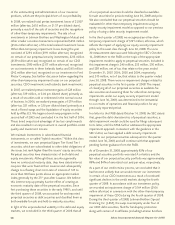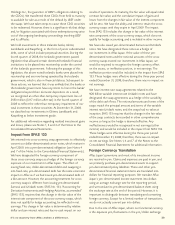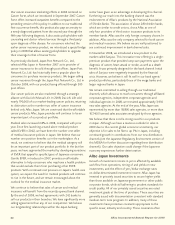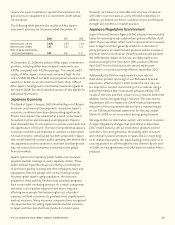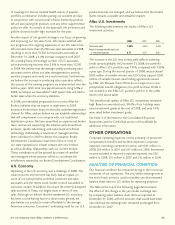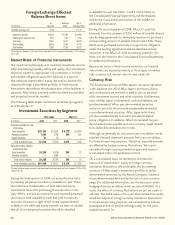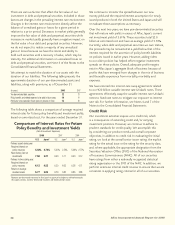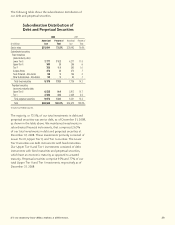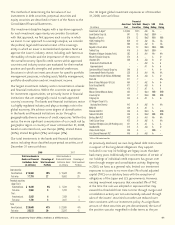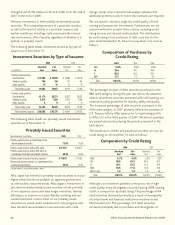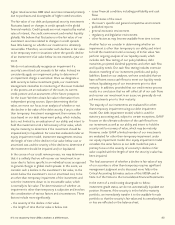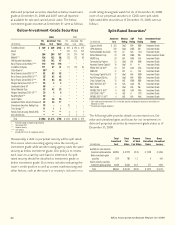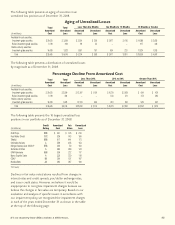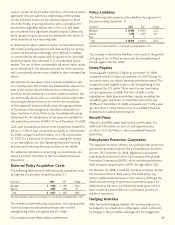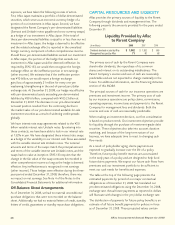Aflac 2008 Annual Report Download - page 42
Download and view the complete annual report
Please find page 42 of the 2008 Aflac annual report below. You can navigate through the pages in the report by either clicking on the pages listed below, or by using the keyword search tool below to find specific information within the annual report.
38 Aflac Incorporated Annual Report for 2008
There are various factors that affect the fair value of our
investment in debt and perpetual securities. Included in those
factors are changes in the prevailing interest rate environment.
Changes in the interest rate environment directly affect the
balance of unrealized gains or losses for a given period in
relation to a prior period. Decreases in market yields generally
improve the fair value of debt and perpetual securities while
increases in market yields generally have a negative impact on
the fair value of our debt and perpetual securities. However,
we do not expect to realize a majority of any unrealized
gains or losses because we have the intent and ability to
hold such securities until a recovery of value, which may be
maturity. For additional information on unrealized losses on
debt and perpetual securities, see Note 3 of the Notes to the
Consolidated Financial Statements.
We attempt to match the duration of our assets with the
duration of our liabilities. The following table presents the
approximate duration of our yen-denominated assets and
liabilities, along with premiums, as of December 31.
The following table shows a comparison of average required
interest rates for future policy benefits and investment yields,
based on amortized cost, for the years ended December 31.
We continue to monitor the spread between our new
money yield and the required interest assumption for newly
issued products in both the United States and Japan and will
re-evaluate those assumptions as necessary.
Over the next two years, we have yen-denominated securities
that will mature with yields in excess of Aflac Japan’s current
net investment yield of 3.61%. These securities total $2.0
billion at amortized cost and have an average yield of 5.74%.
Currently, when debt and perpetual securities we own mature,
the proceeds may be reinvested at a yield below that of the
interest required for the accretion of policy benefit liabilities
on policies issued in earlier years. However, adding riders
to our older policies has helped offset negative investment
spreads on these policies. Overall, adequate profit margins
exist in Aflac Japan’s aggregate block of business because of
profits that have emerged from changes in the mix of business
and favorable experience from mortality, morbidity and
expenses.
We have entered into interest-rate swap agreements related
to our ¥20 billion variable interest rate Uridashi notes. These
agreements effectively swap the variable interest rate Uridashi
notes to fixed rate notes to mitigate our exposure to interest
rate risk. For further information, see Notes 4 and 7 of the
Notes to the Consolidated Financial Statements.
Credit Risk
Our investment activities expose us to credit risk, which
is a consequence of extending credit and/or carrying
investment positions. However, we continue to adhere to
prudent standards for credit quality. We accomplish this
by considering our product needs and overall corporate
objectives, in addition to credit risk. In evaluating the initial
rating, we look at the overall senior issuer rating, the explicit
rating for the actual issue or the rating for the security class,
and, where applicable, the appropriate designation from the
Securities Valuation Office (SVO) of the National Association
of Insurance Commissioners (NAIC). All of our securities
have ratings from either a nationally recognized statistical
rating organization or the SVO of the NAIC. In addition, we
perform extensive internal credit reviews to ensure that we are
consistent in applying rating criteria for all of our securities.
(In years)
2008
2007
Yen-denominated debt securities 12 13
Policy benefits and related expenses to be paid in future years 14 14
Premiums to be received in future years on policies in force 10 10
Comparison of Interest Rates for Future
Policy Benefits and Investment Yields
(Net of Investment Expenses)
2008 2007 2006
U.S. *Japan* U.S. *Japan* U.S. *Japan*
Policies issued during year:
Required interest on
policy reserves 5.50% 2.74% 5.50% 2.74% 5.50% 2.77%
New money yield on
investments 7.56 3.27 6.40 3.11 6.40 3.12
Policies in force during year:
Required interest on
policy reserves 6.12 4.55 6.20 4.63 6.28 4.71
Return on average
invested assets 6.77 3.82 6.79 3.83 6.86 3.88
* Represents yen-denominated investments for Aflac Japan that support policy obligations and therefore excludes
Aflac Japan’s annuities, and dollar-denominated investments and related investment income


